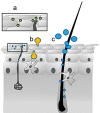Nanoparticles for transcutaneous vaccination
- PMID: 21854553
- PMCID: PMC3815776
- DOI: 10.1111/j.1751-7915.2011.00284.x
Nanoparticles for transcutaneous vaccination
Abstract
The living epidermis and dermis are rich in antigen presenting cells (APCs). Their activation can elicit a strong humoral and cellular immune response as well as mucosal immunity. Therefore, the skin is a very attractive site for vaccination, and an intradermal application of antigen may be much more effective than a subcutaneous or intramuscular injection. However, the stratum corneum (SC) is a most effective barrier against the invasion of topically applied vaccines. Products which have reached the stage of clinical testing, avoid this problem by injecting the nano-vaccine intradermally or by employing a barrier disrupting method and applying the vaccine to a relatively large skin area. Needle-free vaccination is desirable from a number of aspects: ease of application, improved patient acceptance and less risk of infection among them. Nanocarriers can be designed in a way that they can overcome the SC. Also incorporation into nanocarriers protects instable antigen from degradation, improves uptake and processing by APCs, and facilitates endosomal escape and nuclear delivery of DNA vaccines. In addition, sustained release systems may build a depot in the tissue gradually releasing antigen which may avoid booster doses. Therefore, nanoformulations of vaccines for transcutaneous immunization are currently a very dynamic field of research. Among the huge variety of nanocarrier systems that are investigated hopes lie on ultra-flexible liposomes, superfine rigid nanoparticles and nanocarriers, which are taken up by hair follicles. The potential and pitfalls associated with these three classes of carriers will be discussed.
© 2011 The Authors; Microbial Biotechnology © 2011 Society for Applied Microbiology and Blackwell Publishing Ltd.
Figures

Similar articles
-
Current Progress in Particle-Based Systems for Transdermal Vaccine Delivery.Front Immunol. 2020 Feb 26;11:266. doi: 10.3389/fimmu.2020.00266. eCollection 2020. Front Immunol. 2020. PMID: 32174915 Free PMC article. Review.
-
Transcutaneous vaccines: novel advances in technology and delivery for overcoming the barriers.Vaccine. 2011 Aug 26;29(37):6179-90. doi: 10.1016/j.vaccine.2011.06.086. Epub 2011 Jul 6. Vaccine. 2011. PMID: 21740946 Review.
-
A highlight on lipid based nanocarriers for transcutaneous immunization.Curr Pharm Biotechnol. 2015;16(4):371-9. doi: 10.2174/1389201016666150206105552. Curr Pharm Biotechnol. 2015. PMID: 25658381 Review.
-
Transfollicular delivery takes root: the future for vaccine design?Expert Rev Vaccines. 2014 Jan;13(1):5-7. doi: 10.1586/14760584.2014.862500. Expert Rev Vaccines. 2014. PMID: 24428204
-
Overcoming or circumventing the stratum corneum barrier for efficient transcutaneous immunization.Drug Discov Today. 2018 Jan;23(1):181-186. doi: 10.1016/j.drudis.2017.09.017. Epub 2017 Oct 5. Drug Discov Today. 2018. PMID: 28988995 Review.
Cited by
-
Kinetic analysis and evaluation of the mechanisms involved in the resolution of experimental nontypeable Haemophilus influenzae-induced otitis media after transcutaneous immunization.Vaccine. 2013 Jul 25;31(34):3417-26. doi: 10.1016/j.vaccine.2012.10.033. Epub 2012 Oct 22. Vaccine. 2013. PMID: 23092856 Free PMC article.
-
Current Progress in Particle-Based Systems for Transdermal Vaccine Delivery.Front Immunol. 2020 Feb 26;11:266. doi: 10.3389/fimmu.2020.00266. eCollection 2020. Front Immunol. 2020. PMID: 32174915 Free PMC article. Review.
-
Is There an Optimal Formulation and Delivery Strategy for Subunit Vaccines?Pharm Res. 2016 Sep;33(9):2078-97. doi: 10.1007/s11095-016-1979-0. Epub 2016 Jul 5. Pharm Res. 2016. PMID: 27380191 Review.
-
Nanovaccines: Merits, and diverse roles in boosting antitumor immune responses.Hum Vaccin Immunother. 2022 Nov 30;18(6):2119020. doi: 10.1080/21645515.2022.2119020. Epub 2022 Sep 28. Hum Vaccin Immunother. 2022. PMID: 36170662 Free PMC article. Review.
-
Antigen Uptake After Intradermal Microinjection Depends on Antigen Nature and Formulation, but Not on Injection Depth.Front Allergy. 2021 Apr 8;2:642788. doi: 10.3389/falgy.2021.642788. eCollection 2021. Front Allergy. 2021. PMID: 35386985 Free PMC article.
References
-
- Antonelli A., Ferri C., Ferrari S.M., Colaci M., Sansonno D., Fallahi P. Endocrine manifestations of hepatitis C virus infection. Nat Clin Pract Endocrinol Metab. 2009;5:26–34. - PubMed
-
- Apple R.J., Erlich H.A., Klitz W., Manos M.M., Becker T.M., Wheeler C.M. HLA DR‐DQ associations with cervical carcinoma show papillomavirus‐type specificity. Nat Gen. 1994;6:157–162. - PubMed
-
- Babiuk S., Baca‐Estrada M., Babiuk L.A., Ewen C., Foldvari M. Cutaneous vaccination: the skin as an immunologically active tissue and the challenge of antigen delivery. J Control Release. 2000;66:199–214. - PubMed
-
- Bal S.M., Slutter B., van Riet E., Kruithof A.C., Ding Z., Kersten G.F. Efficient induction of immune responses through intradermal vaccination with N‐trimethyl chitosan containing antigen formulations. J Control Release. 2010;142:374–383. et al. - PubMed
-
- Bond J.R., Barry B.W. Hairless mouse skin is limited as a model for assessing the effects of penetration enhancers in human skin. J Invest Dermatol. 1988;90:810–813. - PubMed
Publication types
MeSH terms
Substances
LinkOut - more resources
Full Text Sources
Medical
Miscellaneous

